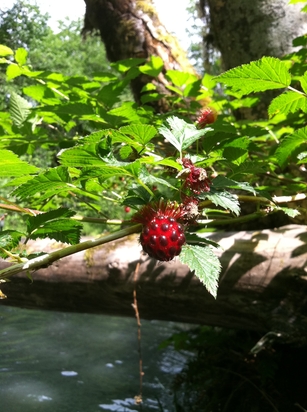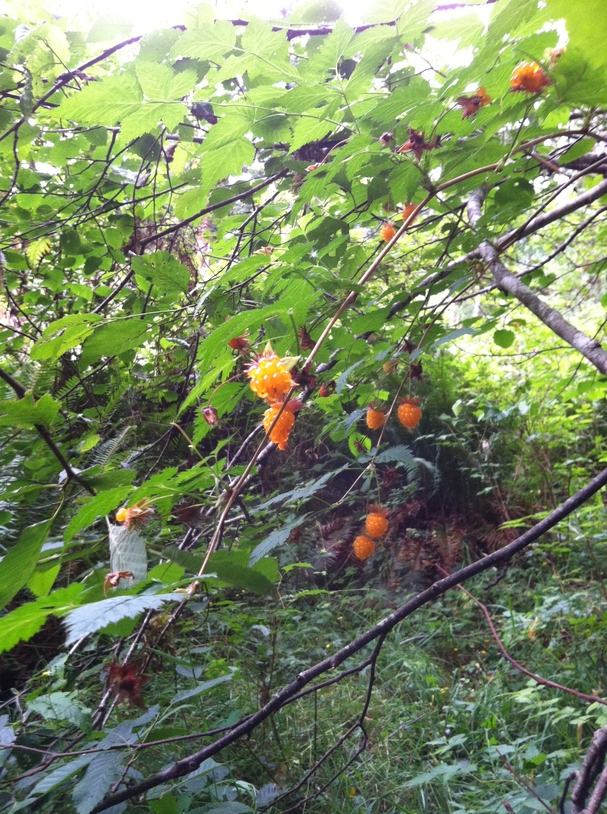 |
Canku Ota
|
 |
|
(Many Paths)
|
||
|
An Online Newsletter
Celebrating Native America
|
||
|
July 2016 - Volume 14
Number 7
|
||
|
|
||
|
Nature 911: Enjoy
Them Now Wild Berries Are Ripe
|
||
|
by Lynda V. Mapes -
Seattle Times
|
||
| I speak here not of the Himalayan blackberries, an invasive
that come August rewards us with succulent fruit for the space it
devours. No, here I am talking about the wild, native berries just
now gleaming in the forests and river valleys, the food that has helped
sustained the native people and wildlife of this place for as long
as there have been summers in Puget Sound.
On a recent hike in the Elwha Valley my progress was seriously slowed, not by tough terrain, but by the seduction of berries. Salmonberries, soft, juicy, gorgeous, in every shade of yellow, orange and deep red. Wet with rain, cool, refreshing, oh there is no more Olympic valley taste than a salmonberry savored on the trail. And then there were the wild strawberries, tiny, vivid, sharply fragrant. Not for nothing are the Swainson's thrush, the bird with its haunting, upward arpeggio, singing away now, too. Their song and the ripening of salmonberries are coincident, and salmonberries are an important food source for these birds, whose song is a signature of the Puget lowland forest in summer, particularly as evening comes on. To be in a Puget Sound river valley and hear water and Swainson's while plucking a perfectly ripe salmonberry shining with rain -- that's knowing all is right with at least a tiny part of the world. That, and walking up the trail, grazing the backs of your hands on the tall, wet sword ferns, to soothe a long hike's nettle stings... Now that's a Puget lowland forest experience to me. Here's a sampling of what awaits you on the trail -- all the berries are late this year, but they are delicious right now.
Sally Brownfield, a member of the Squaxin Island Tribe, grew up picking berries on her family's land in Kamilche, Mason County. For Coast Salish tribes, berries are an important food source, but also a cultural touchstone. The gathering is as importance as the eating, Brownfield said. "I have been picking blackberries ever since I was little with my Mom, and we got told all the family history when we went out picking. My mom had eight kids, and when my mom was a young lady, they didn't have freezers, they had to pick enough to have 100 quarts before they could have a pie, to make sure they had food for the winter. When you were out picking blackberries you did not eat them in the field, we got up really early in the morning just as it was daylight, and you learned a lot of discipline." And she isn't talking about the big, non-native Himalayan blackberries, but the tiny, succulent, trailing blackberry, Washington's only native blackberry. Busy as she is today as education director for her tribe, Brownfield said she still makes time to pick. "The trailing blackberries are ripening now, it is time to pick, they are calling me," she said. Brownfield was kind enough to dig in her personal photo albums to share pictures of berries in traditional baskets she showed me when we first met years ago, when I began covering tribes for the newspaper. Her pictures, to me, show the love and care that goes into finding, picking, and sharing traditional foods.
Brownfield remembered during the Columbus Day storm it was the family's store of blackberries they lived on when fallen trees sealed off any road access to their home. "We couldn't get to town for over a week, and we lived on those berries. We made pies and blackberry dumplings." When her mother passed away, Brownfield said she knew just what she had to do. "My tribute to her was to make enough blackberry pies to make sure all the people that came had blackberry pie. That was the thing that meant the most to me." She made 13. While they are a wild crop, traditionally, tribal people managed their berry picking areas, Brownfield said. "The people would burn the areas, so it wouldn't be overgrown, and the soil would be rich and the berries would come back in the same place."
Today access is the big issue. As timberlands are gated off or forestland is converted to development, traditional gathering areas are being lost, Brownfield said. "You remember the past times you had there with your family, you know what birds should be there, and the sounds the different animals are making, you learn those things when you are out there, in the quiet." The gathering of first foods, as traditional foods are also called, is more important than ever as the link between diet and diabetes has come to be better understood. Sally said she is planning to teach tribal youth about the use of salal berries, naturally high in pectin, as a low-sugar alternative for jams. She said novice gatherers should be careful about what they pick, but there is one sure guide to which berries are tasty and good: "You watch the birds, and if they don't eat them, you don't either." Too soft to be dried or stored, salmonberries usually are eaten fresh, right out of hand. Salmonberries often are found in wet places. Along the Elwha River, I encountered them in profusion this year. Perhaps a gift of all our moisture? Even from a distance, they gleamed in the gloaming of the deep forest.
To me the twin artistry of basket weaving and gathering are beautifully captured in these photos, taken by Brownfield, of family heirloom baskets, holding freshly-gathered berries:
Brownfield writes: "The large basket (1920's) with the blue elderberries was my great Aunt's (1880's-1972). It's a lunch basket I used when my kids were small for picnics but it works great for the blue elderberries. The smaller basket with handle holding wild trailing blackberries was made by Theresa Nason ( Squaxin Island, 1980's). Both of these are made of cattail and raffia." |
|||||||||
|
|
|
||
|
|
||
| Canku Ota is a free Newsletter celebrating Native America, its traditions and accomplishments . We do not provide subscriber or visitor names to anyone. Some articles presented in Canku Ota may contain copyright material. We have received appropriate permissions for republishing any articles. Material appearing here is distributed without profit or monetary gain to those who have expressed an interest. This is in accordance with Title 17 U.S.C. Section 107. | ||
|
Canku Ota is a copyright ©
2000 - 2016 of Vicki Williams Barry and Paul Barry.
|
||
 |
 |
|
|
The "Canku
Ota - A Newsletter Celebrating Native America" web site and
its design is the
|
||
|
Copyright ©
1999 - 2016 of Paul C. Barry.
|
||
|
All Rights Reserved.
|
||




